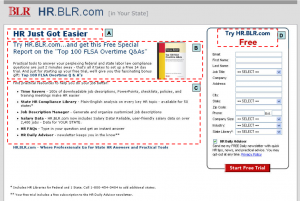 Thirteen best practices to consider when testing the elements of your website landing pages.
Thirteen best practices to consider when testing the elements of your website landing pages.
Bob Brady, CEO of Business & Legal Reports opened his Landing Page Optimization session yesterday at the Mequoda Summit with this question:
Why is a renewal rate like a spouse, and a landing page conversion rate like a date?
Bob’s answer: “It is easy to change the behavior of a date, and hard to change that of a spouse.” In comes the chuckling audience.
“A landing page is the pressure point in a transaction that you have the ability to change,” Bob told attendees.
Bob explained that A/B testing hasn’t changed all that much since the golden age of direct mail. He noted that the only thing that has changed is how limited it once was. Back in the day, you were limited by costs, a 4-5 month cycle, and by the size of your list. “Despite limitations, it worked,” he noted.
Bob told the audience of their days with Vertster, the original tool they used for a/b testing. The results BLR got from Vertster were “sometimes counter-intuitive but always instructive.”
While he continued to speak highly of the company, Bob told the audience that they ultimately took their $1500/mo Vertster bill out of the budget in favor of the free Google Website Optimizer tool.
[text_ad]
Bob and his team have developed a list of thirteen testing best practices over the years that he shared with the Mequoda Summit group:
- Have a techie in marketing – somebody who understands the Google technology and how your site works.
- Have your techie go through Google’s Adwords training program.
- Test big things first (page design, headlines, long vs. short) before little things (color of buttons, size of text).
- Test high-volume pages and apply those lessons to low-volume pages.
- Limit your tests to pages that get traffic from a common source – e.g., a Google Adwords campaign.
- Keep your tests simple.
- Test “distracting” links, like “free sample issue”.
- Consider the ROI of the entire process, not just a single page
- Keep records of your tests and take screenshots of everything
- Share what you learn with the email marketers and web designers.
- Use your web-analytics data to uncover high-impact pages or user paths to test.
- Choose your goal, first. Then, decide which elements to test
- Know which metrics will be used to declare a winner and make sure you can get those numbers.
If you’re interested in the 11 other sessions from the Mequoda Summit, you might consider becoming a member of Mequoda Pro, our online training library.
At the moment, Mequoda Pro contains eight sessions, transcripts and tools from our Boston Summit last October. By May 1st, Mequoda Pro will host all twelve sessions and tools from this year’s event. Learn more about Mequoda Pro…
Today is also the first day you can register for the Mequoda Summit Boston 2009 on October 7-9 for the early-bird price of just $897. Learn more about the Mequoda Summit….


